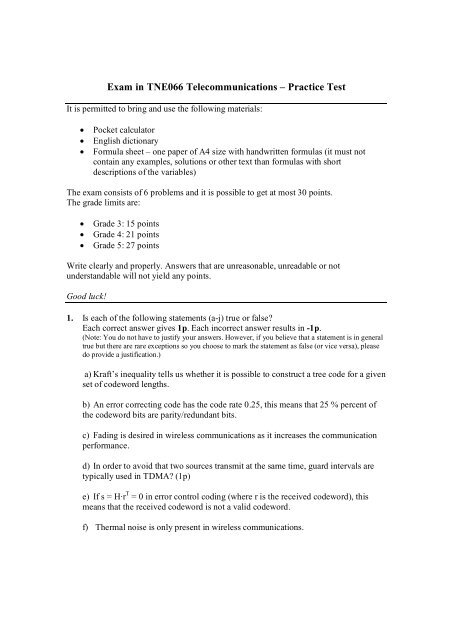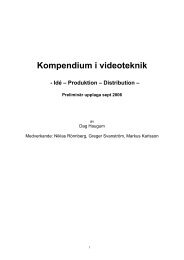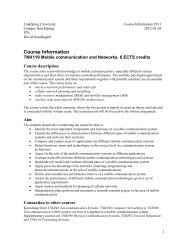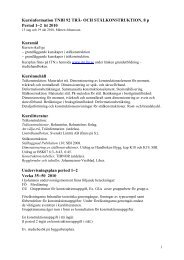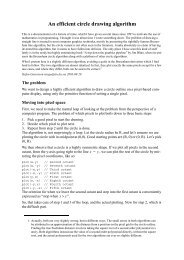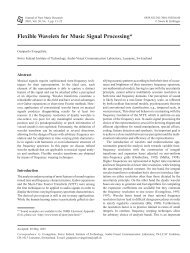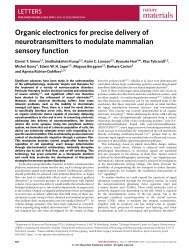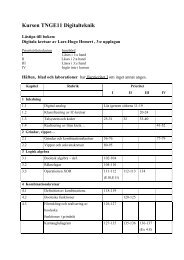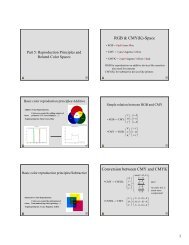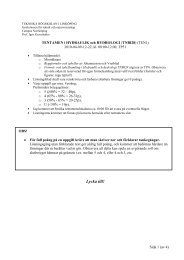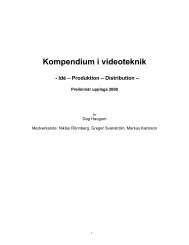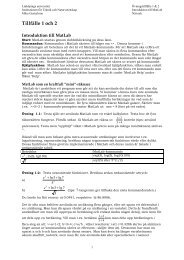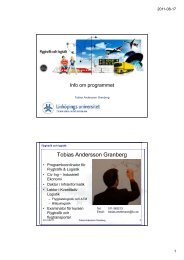Exam in TNE066 Telecommunications – Practice Test
Exam in TNE066 Telecommunications – Practice Test
Exam in TNE066 Telecommunications – Practice Test
You also want an ePaper? Increase the reach of your titles
YUMPU automatically turns print PDFs into web optimized ePapers that Google loves.
<strong>Exam</strong> <strong>in</strong> <strong>TNE066</strong> <strong>Telecommunications</strong> <strong>–</strong> <strong>Practice</strong> <strong>Test</strong><br />
It is permitted to br<strong>in</strong>g and use the follow<strong>in</strong>g materials:<br />
<br />
<br />
<br />
Pocket calculator<br />
English dictionary<br />
Formula sheet <strong>–</strong> one paper of A4 size with handwritten formulas (it must not<br />
conta<strong>in</strong> any examples, solutions or other text than formulas with short<br />
descriptions of the variables)<br />
The exam consists of 6 problems and it is possible to get at most 30 po<strong>in</strong>ts.<br />
The grade limits are:<br />
<br />
<br />
<br />
Grade 3: 15 po<strong>in</strong>ts<br />
Grade 4: 21 po<strong>in</strong>ts<br />
Grade 5: 27 po<strong>in</strong>ts<br />
Write clearly and properly. Answers that are unreasonable, unreadable or not<br />
understandable will not yield any po<strong>in</strong>ts.<br />
Good luck!<br />
1. Is each of the follow<strong>in</strong>g statements (a-j) true or false?<br />
Each correct answer gives 1p. Each <strong>in</strong>correct answer results <strong>in</strong> -1p.<br />
(Note: You do not have to justify your answers. However, if you believe that a statement is <strong>in</strong> general<br />
true but there are rare exceptions so you choose to mark the statement as false (or vice versa), please<br />
do provide a justification.)<br />
a) Kraft’s <strong>in</strong>equality tells us whether it is possible to construct a tree code for a given<br />
set of codeword lengths.<br />
b) An error correct<strong>in</strong>g code has the code rate 0.25, this means that 25 % percent of<br />
the codeword bits are parity/redundant bits.<br />
c) Fad<strong>in</strong>g is desired <strong>in</strong> wireless communications as it <strong>in</strong>creases the communication<br />
performance.<br />
d) In order to avoid that two sources transmit at the same time, guard <strong>in</strong>tervals are<br />
typically used <strong>in</strong> TDMA? (1p)<br />
e) If s = H·r T = 0 <strong>in</strong> error control cod<strong>in</strong>g (where r is the received codeword), this<br />
means that the received codeword is not a valid codeword.<br />
f) Thermal noise is only present <strong>in</strong> wireless communications.
g) Quantization is performed to obta<strong>in</strong> a digital representation of an analog signal<br />
that has been sampled.<br />
h) The strategy of the OOK modulation technique is to represent digital data as the<br />
presence or absence of a carrier wave.<br />
i) Soft decision decod<strong>in</strong>g typically results <strong>in</strong> greater performance compared to hard<br />
decision decod<strong>in</strong>g.<br />
j) The Go-back-N ARQ technique is restricted to only send one s<strong>in</strong>gle data packet<br />
at a time, and an acknowledgement needs to be received before the next packet may<br />
be transmitted.<br />
2. A signal x(t) = s<strong>in</strong>(500πt) is sampled and then reconstructed ideally. Determ<strong>in</strong>e the<br />
output y(t) after ideal reconstruction if the sampl<strong>in</strong>g frequency f s is:<br />
a) f s = 600 Hz. (2p)<br />
b) f s = 300 Hz. (2p)<br />
3. A step-<strong>in</strong>dex fiber is surrounded by air. The cladd<strong>in</strong>g has refraction <strong>in</strong>dex 1.2 and the<br />
core has refraction <strong>in</strong>dex 1.4.<br />
a) Determ<strong>in</strong>e the angle of refraction if the light <strong>in</strong> the core reaches the junction<br />
between the core and the cladd<strong>in</strong>g with an angle of <strong>in</strong>cidence that is 40 o . (1p)<br />
b) Determ<strong>in</strong>e the critical angle of the core/cladd<strong>in</strong>g junction. (1p)<br />
c) Determ<strong>in</strong>e the acceptance half angle of the fiber. (1p)<br />
d) Briefly describe two types of losses that are associated with optical fiber. (1p)<br />
4. A memoryless source produces the symbols A, B, C, D, E, F, G, H with the<br />
probabilities P A = 0.28, P B = 0.20, P C = 0.15, P D = 0.06, P E = 0.18, P F = 0.05, P G<br />
= 0.07, P H = 0.01.<br />
a) Determ<strong>in</strong>e the average codeword length that can be achieved with a tree code<br />
(Huffman code) which encodes one symbol at a time. (2p)<br />
b) Calculate the compression ratio and the redundancy. (2p)
5. a) Create the generator matrix G and the parity check matrix H for a l<strong>in</strong>ear error<br />
correct<strong>in</strong>g block code with the parameters (n, k, d) = (8, 2, 4). (2p)<br />
b) How many errors can the code detect and correct? (2p)<br />
6. The m<strong>in</strong>imum Euclidean distance d between symbols <strong>in</strong> a signal space diagram is<br />
often used as a quality measure for data transmission systems. Sometimes the<br />
normalized distance<br />
d<br />
is used <strong>in</strong>stead, where E is either the maximum or<br />
E<br />
average energy of the signal constellation.<br />
S<strong>in</strong>ce d depends on the energy E of the signals, determ<strong>in</strong>e the value of the<br />
normalized m<strong>in</strong>imum distance for 16-PSK and 16-QAM when:<br />
a) E corresponds to the maximum energy of the constellation. (2p)<br />
b) E corresponds to the average energy of the constellation. (2p)<br />
H<strong>in</strong>t: The symbol error probability of 16-PSK can also be written as:<br />
P e<br />
<br />
<br />
2 Q<br />
<br />
<br />
d<br />
2<br />
2 N<br />
0


